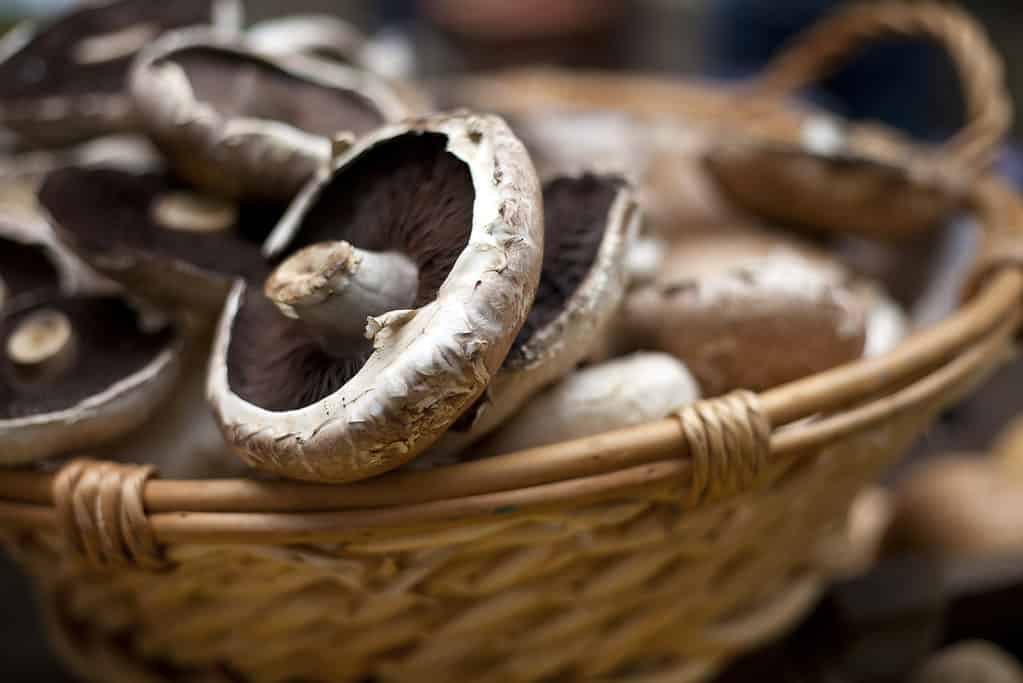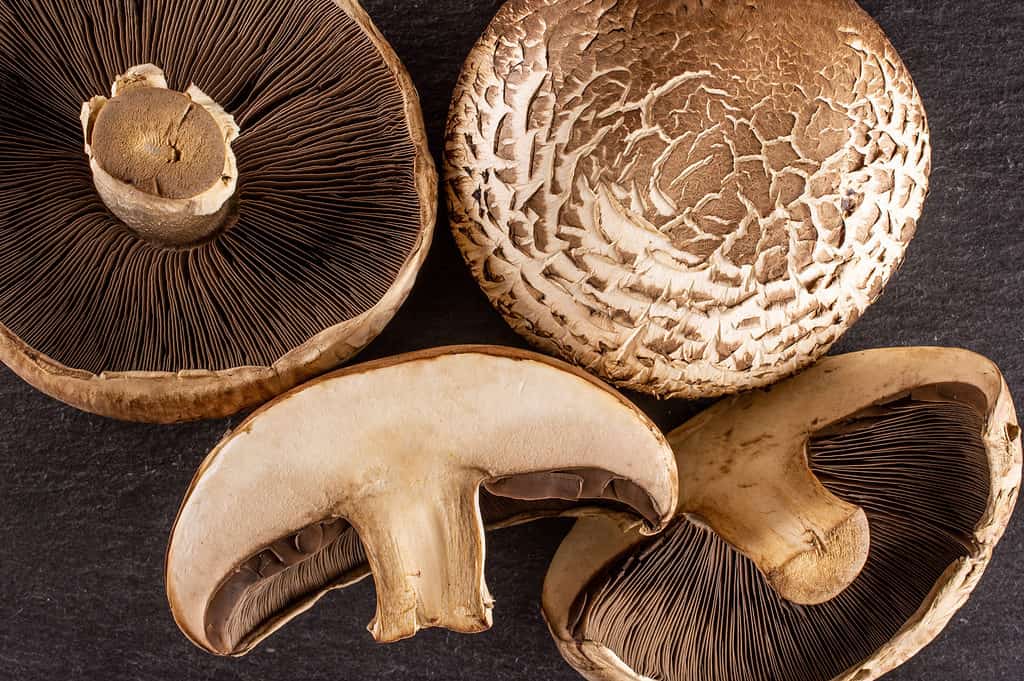What’s not to love about portobello mushrooms? These delicious fungi have rich umami flavor, multiple health benefits, and a meaty texture. One look at the large-sized mushrooms, and you can imagine a variety of flavorful recipes. These mushrooms can be sautéed, grilled, baked, stuffed, or served as a meat substitute in tacos and on burgers. Regardless of your jam, portobello mushrooms have all-around yumminess.
The portobello mushroom has alternative spellings, including portabella, portobello, and other names such as giant cremini (or crimini). This mushroom species belongs to Agaricus bisporus, which also comprises white button and cremini mushrooms.
The Agaricus bisporus is one of the most produced and consumed mushrooms globally, cultivated in more than 70 countries. The grasslands of Europe and North America are the native homes of the species.
White button mushroom is the least mature variant, followed by the intermediate-stage cremini. According to the Mushroom Council, almost 90% of the mushrooms eaten in the United States are white button mushrooms.
With a cap that measures up to 6 inches in diameter, the dark brown portobello mushroom is the biggest and most mature of its relatives.
Growing Portobello Mushrooms

©Magdanatka/Shutterstock.com
If your love for portobello mushrooms has you pondering mushroom farming, you’re not alone. Because so many people are interested in growing these beauties, we’ve compiled the best practices for growing portobellos successfully. They’re relatively easy to grow and can survive indoors and outdoors in a range of temperatures.
Typically, all mushrooms grow through spores, unlike plants that require seeds. The spores are so tiny that a microscope is needed to see each one. Up to 16 billion spores may be shed by a mature mushroom.
Spores must be harvested in a germ-free laboratory to create spawn, the mushroom farmer’s equivalent of a seed. However, to cut out the search for spores and speed up the process, you can grow portobello mushrooms with store-bought ends.
Portabella mushrooms flourish in a humid, moderate climate. They thrive in temperatures between 55 and 74 °F (12.7- 23.3 °C) and relative humidity levels of about 85%. The optimum location for portabella mushrooms is an area without direct sunlight. Unfiltered exposure to the sun might cause drying or overheating.
You have a few alternatives to consider as a growing medium for your portobello mushrooms. First, you can opt for compost, which you can DIY or buy. Before using compost as a growing medium, ensure it has completely broken down and is free of contaminants.
Compost is made out of organic waste from the kitchen and the yard, including vegetable scraps, eggshells, and animal droppings or manure.
Using substrate is another option. Substrates expressly made for growing mushrooms are available online and at gardening stores.
Wondering if you can use soil? Absolutely. Just make sure it’s clean, pH-neutral, and high quality.
How to Grow Portobello Mushrooms Inside
Most people prefer to cultivate their portobello mushrooms indoors because they can be produced throughout the year, and it’s easier to regulate the climate. You should definitely try this option if you live in a chilly region or have little outside space.
Set Up Your Tray or Growing Kit
The first step is to assemble a tray from new planks or leftover wood as part of your growing kit. The tray should be about 20cm (7.8 inches) deep. Alternatively, buy a ready-made mushroom growing kit from a gardening supply store or online retailer. It comes with everything you need to cultivate portobello mushrooms.
Fill with Compost and Mushroom Spores
Add your manure-based compost to the tray until it’s halfway full. Then, sprinkle spores on the compost and gently stir them until they are 2.5 cm deep. Place the tray in a dark place and watch for the growth of spores, which resembles a white, filmy web. Maintain a 60 to 70°F (15.5 – 21°C) temperature range.
Introduce Peat Moss and Add Water Regularly
Grab some peat moss, spread it over the tray, and then cover it with newspaper. You must spritz the newspaper twice a day with distilled water for a couple of weeks.
As you notice mushroom heads, you can permanently remove the newspaper. Keep an eye on the development of your portobello mushrooms at regular intervals. Keep misting the tray every day after the newspaper has been taken out.
Harvest Your Portobello Mushrooms
Now, we move on to the best part. You can harvest the portobello mushrooms once they reach your preferred size. Otherwise, continue spraying them daily and keep them in a space between 65 and 70°F (18.3 – 21°C) until you’re ready. The dark brown caps should be about 4-6 inches (10.2 – 15.2 cm) in diameter at maturity.
We recommend harvesting while the caps are completely flat rather than with a slight downward bend. Then, using your hands, remove them from the compost, clean them, and store them in a cool, dry place or a refrigerator.
You don’t have to stop at one harvesting cycle. Keep moistening the compost untillfresh mushrooms begin to appear. You can add a new batch of newspapers if you notice new white streaks forming.
How to Grow Portobello Mushrooms Outside
Portobello mushrooms can be grown outdoors provided they’re kept in a shaded place and the temperature doesn’t go beyond 60-70°F (15.5 – 21°C). Growing on a raised bed is a popular choice due to easy operation. Here are the steps to follow:
Construct a Raised Bed and Fill it with Compost
As always, step one is to prepare the growing space for your mushrooms. Make a raised bed about 8 inches deep with a 4 x 4 dimension. The walls can be constructed from logs, concrete blocks, or bricks.
Ensure that the bed is at least 6 inches deep with mature compost. Then, cover the bed’s surface with old newspapers and the rest of it with black plastic. Let it sit for about two weeks. This process disinfects the bed through sun radiation and eliminates damage-causing microorganisms.
Disperse Mushroom Spores
Remove the newspaper layers and black plastic at the end of two weeks. Sprinkle spores equally across the bed and mix gently to incorporate them into the compost. Wait another two weeks, but keep an eye out for the usual white filmy web.
Layer with Peat Moss
Like with the indoor procedure, cover your bed with a layer of peat moss and newspaper when you spot the spores’ growth. Spray the newspaper with distilled water twice daily for 10 days to moisten the developing portobello mushroom spores.
The beds might become a haven for mosquitoes if the soil becomes waterlogged. Remove the newspaper once you can see the mushroom heads emerge, and keep misting the mushrooms as they grow.
Harvest
You can harvest mature portobello mushrooms when the caps are about 4-6 inches in diameter. When choosing portobello mushrooms for cooking, select firm, whole mushrooms and refrain from eating squishy, wilted mushrooms and those destroyed by insects or birds.
With their rapid growth, these mushrooms can be harvested in three batches over two to three weeks before additional spores are required.
How to Grow Portobello Mushrooms from Store-Bought Stems
You can produce a crop of portobello mushrooms from the wasted mushroom stems. It’s a great technique to upcycle food waste. Although mushroom spores are recommended for beginners due to the higher chances of success, growing portobello mushrooms from stems is actually achievable. If you’re up for it, why not?
For a start, you have to curate a growing kit. You can layer your preferred growing medium with black plastic, cardboard boxes, or paper bags to retain moisture and restrict excessive light. Cover the bottom of the medium with your chosen moist mushroom substrate and add the mushroom ends. Repeat the process with another layer until the tray is filled.
¼ (6mm) is the optimum stem size for growing portobello mushrooms with store-bought stems. For the best chances of success, make sure moisture, consistent humidity, and an appropriate temperature range are present. (65°F – 75°F). Thus, the growing medium can be inoculated with the spores that the mushroom stems will release. Once you can see white mycelium consuming your substrate, you’re well on your way to harvesting.
Care for Your Portobello Mushrooms

©PIXbank CZ/Shutterstock.com
It’s crucial to take proper care of your portabella mushroom spores once you’ve successfully planted them and they’ve started to germinate so that they grow into the healthy, plentiful mushrooms of your dreams. We’ve highlighted some important factors.
Moisture
Mushrooms require a constant supply of moisture to thrive. A low-cost hygrometer can help you monitor the humidity and moisture if you grow mushrooms in a sterile indoor setting.
Keep your bags or bed somewhat damp if you’re growing mushrooms outside. Use a spray bottle or watering can to spritz your mushrooms regularly or when you notice them drying out.
However, don’t overdo it. Overwatering often causes soggy substrate, rot, mold, and stagnant water. In addition, mold and bacteria thrive in stagnant water, which makes your mycelium more vulnerable to damage.
The same rules apply if you’re growing outdoors. For example, a bed needs sufficient drainage, and it shouldn’t be placed where it will collect water and foster mold growth.
Pest Control
Although portabella mushrooms are typically unyielding to pests and diseases, checking at your plants for any indications of such issues is recommended. Inspect your mushrooms regularly for usual pests like slugs, snails, and insects; if required, take the necessary steps to control them. Uproot the affected mushrooms to avoid spreading diseases to the remaining flush of mushrooms if you spot any disease symptoms, such as discoloration or decay.
Viable Spawn
Your ready-made portobello mushroom growing kit comes with mushroom spawn, not spores. If possible, buy from a reliable local source. This minimizes the travel time for your mushroom spawn and increases the likelihood of a good harvest.
Older or far-traveled spawn may not grow or yield. Don’t leave spawn lying about for too long; it will deteriorate and perhaps get contaminated. Its lifespan can be prolonged by storing it in the refrigerator, but with each passing week, its viability decreases.
Proper Ventilation
Seeing your portobello mushrooms experience stunted growth due to a lack of airflow is a major letdown. Carbon dioxide level rises in a poorly ventilated growing site. Thus, open the enclosed growing space sometimes to let in the fresh air. Be careful, though; fresh air raises the risk of pollutants and depletes the humidity.
Sterile Environment
Maintain a clean environment by keeping a tidy workspace. Otherwise, microorganisms like mold will defeat your mycelium and gain control of your substrate. It’s also important to observe simple guidelines such as frequent handwashing. You can also use pasteurized straw or compost to increase your substrate’s resistance.
The post How to Grow Portobello Mushrooms appeared first on AZ Animals.
from Animal News, Facts, Rankings, and More! - AZ Animals https://ift.tt/ln6bRDc